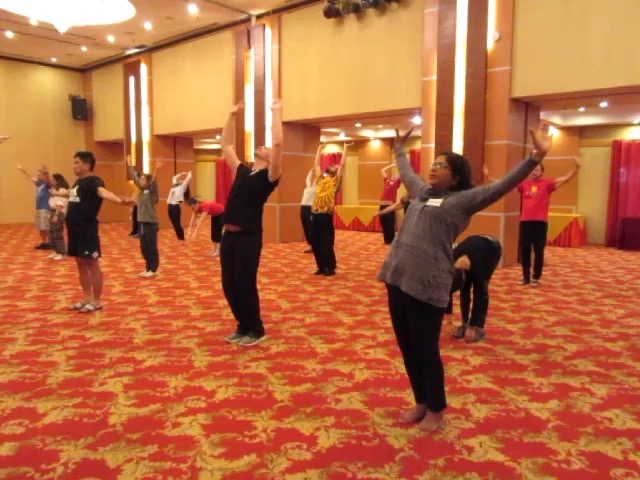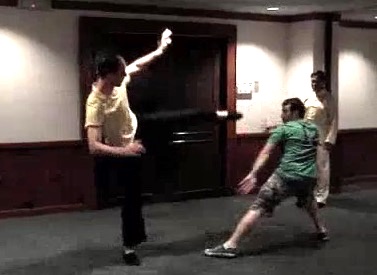SELECTION OF QUESTIONS AND ANSWERS
MAY 2021 PART 2

An Intensive Chi Kung Course in Dec 2019
Question 1
May I know where is your training center and the price in RM for the intensive qigong course.
Is it possible to learn qigong from your training course in such a short period, i.e. to be able to practice to generate qi on my own correctly?
Do you provide detailed notes and videos that's easy enough to serve as revision material to practise at home?
Editorial Note: This question and other questions were asked earlier, but because of a long waiting list, they are only released now.
— Danny, Malaysia
Answer
I don't have a training center at present. I used to travel round the world, but now offer a few intensive courses a year in Penang.The Intensive Chi Kung Course is 1200 euros. Working at the conversion rate of 4.5 ringgit to a euro, it is RM 5400. There is no need for any prior experience in chi kung.
It is understandable for many people to enquire what can be learned in a few days of an intensive course. The answer is that you will learn a lot, especially skills that you will not learn elsewhere. The few days of an intensive course will provide you chi kung skills that range from a beginner's level to a master's level.
At present most people, including so-called masters, practice gentle physical exercise using chi kung forms. Many of them are still sickly and weak. The onus of chi kung is not its forms, which you can learn from good books or videos, but chi kung skills.
You should be able to learn genuine chi kung from my training course in a few days. You should be able to enter into a chi kung state of mind -- i.e. to be relaxed and focused at the same time -- and generate an energy flow. You will also be able to have vitality, longevity, peak performance and spiritual joys irrespective of your religion, or the lack of it.
All important notes will be given at the course. You will also be provided with videos.
The Intensive Chi Kung Course is a fundamental course, and it does not include chi kung healing and chi transmission. Many people, including those with so-called incurable diseases, have recovered from the course, and they lead healthy lives.
Question 2
What would you recommend? Join your beginner class then only proceed to enrol in advance classes of any of your student?
Answer
I would recommend that you attend my Intensive Chi Kung Course. This will be more than sufficient for you. You can repeat the course if you want to. Many people do that.
This is deepening skills, which are more important than learning techniques. You only learn three techniques in the Intensive Chi Kung Course, but you learn many chi kung skills.
Later you can join the Small and Big Universe Course. I used to give a Small Universe Course, and then a Big Universe Course for 6 months more than 30 years ago. Many chi kung practitioners like to practice the Small Universe. It is regarded as "the chi kung". Now I offer the Small Universe and the Big Universe in one course. This is because of my tremendous improvement in teaching chi kung skills.
Other Shaolin Wahnam instructors do not teach the Intensive Chi Kung Course and the Small and Big Universe Course. They leave those to me. But they teach regular classes.
There is a big difference between teaching regular classes by certified instructors and teaching intensive courses by me. In teaching regular classes the emphasis is on practicing, whereas in teaching intensive courses the emphasis is on learning. In practicing, one practices over and over again what he has learned. In learning, he learns what to practice, and he spreads over a longer time over the practice.
At present we have four certified Shaolin Wahnam instructors in Malaysia. They are Dr Foong, Sifu Wong Chun Nga, Sifu Lee Wei Joo and Sifu Bernie Kissey. Dr Foong, who is the director of Holistic Health Cultivation Centre in Kuala Lumpur, is a multi-millionaire; he teaches chi kung for its love. Sifu Wong Chun Nga is my eldest son; he has helped many people overcome so-called incurable diseases. Sifu Lee Wei Joo teaches in Kuala Lumpur. He is quite exclusive. Sifu Bernie Kissey teaches in Sabah. She has helped many people overcome so-called incurable diseases.
If you learn from any one of them, you are guaranteed to learn real, high-level chi kung. Real chi kung is very rare today. Most people practice only its outward forms, like the outward forms of Taijiquan, called Tai Chi Chuan in English. Real chi kung will give good health, vitality, longevity, peak performance and spiritual joys.

A Small and Big Universe Course in April 2019. Sifu Bernie Kissey is at the foreground on the right
Question 3
I myself am learning Aikido and I am still learning to do it correctly.
Answer
If you practice Aikido, you may find the following webpages useful:
You may learn Shaolin Kungfu from me, but it needs some prior experience. Please see my website. Or you can learn from one of our instructors.Question 4
Would I able to cure myself of some non-life threatening diseases at the end of the course or must I enrol in a healer or an advanced course for that?
Answer
When you attend my Intensive Chi Kung Course, which can be taken without any prior chi kung experience, you will overcome your non-life threatening diseases. You will have good health, vitality, longevity, peak performance, and be happy and peaceful every day. It is easy to perform the various chi kung exercises once you have the skills

Sifu Eugene defends a side kick with "Tame Tiger with String of Beads"
Question 5
Where would "Five Dantian Breathing" fit into this list?
— Sifu Leonard Lackinger, Shaolin Wahnam Wien
Answer
"Five Dantian Breathing" is very advanced. It is spiritual chi kung, and should be placed at the bottom of the list between 16 and 17, i.e. between "Small Universe" and "Phenomenal Big Universe".
This is speaking relatively by those who can perform "Five Dantian Breathing" and other types of chi kung. Most people perform chi kung as gentle physical exercise.
Question 6
Is there a story behind the pattern, "Tame a Tiger with a String of Beads"?
Answer
There is no official story behind the pattern, "Tame Tiger with String of Beads".
But I could imagine that when a tiger pounced on a Lohan, who was a direct disciple of the Buddha, the Lohan, instead of using his palm which would kill the tiger, could use his string of beads to tie the tiger. He would use his frontal or sideway Arrow-Bow Stance, which is a typical stance for the pattern.
I thought of the imagination when I figured out the pattern to avoid a powerful kick many, many years ago.

Sifu Leonard Lackinger with the Wudang Sword
Question 7
In history, there were different versions of the "18 weapons" during various dynasties. What would be your selection?
Answer
Of the different versions of the 18 weapons, I favoured the latest version, or the Qing version. The weapons are spear, crescent-moon spear, staff, battle-axe, big trident, halberd, lance, rope-spear, scimitar, sword, hand-axe, hook-sword, rod, soft-whip, clutch, round hammer, and daggers.
Except the rope-spear, the hook-sword and the clutch, I know all the weapons. This is actually not bad. If a person knows 4 or 5 weapons, he is considered good.
It is interesting that I don't know the clutch. It was the weapon of our patron immortal, Immortal Li. The clutch is quite popular in Karate, but not in kungfu.
Question 8
You read a legend about a master jumping up to a Lei Tai and landing in "Flowing Breeze Swaying Willows". Is my memory correct? Which story and master does this refer to?
Answer
The young master was Fong Sai Yuk. He was only 15 when he jumped up a lei-tai, or a platform where duels were held with no rules applied, and had a life-death duel with Tiger Looi, showing that in kungfu, age, size as well as gender are not decisive factors.
Tiger Looi was a formidable fighter, killing many people earlier. "Tiger Looi" was his nick-name, demonstrating his courage and fighting ability; his real name was Looi Hoong.
Tiger Looi set up a lei-tai, literally meaning "thunder-platform", but figuratively it refers to life-death duels. Outwardly it was to meet heroes of the world, but secretly it was to find out more about the Red Flower Society, who were good kungfu fighters to overthrow the Qing Dynasty.
I still remember the scene clearly after more than 60 years. Fong Sai Yuk gave a low punch in the pattern, "Precious Duck Swims through Lotus". Tiger Looi swept at Fong Sai Yuk's arm, attempting to break it, using the pattern, "False Leg Hand Sweep". At the time listening to the story, I knew the hand sweep was a block; I didn't know it was "no-defence-direct-counter". The patterns were actually mentioned in the legend.
Fong Sai Yuk pulled back his hand, and moved forward with a punch at the solar plexus, using the pattern, "Black Tiger Steals Heart", very similar to Uncle Righteousness' cup fist. This ended Tiger Looi's life.
Li Siew Wan, the wife of Tiger Looi, wanted to avenge her husband's death. She injured Fong Sai Yuk, with her specialty, "heart-penetrating kick", even when he was wearing a "heart-protection shield". Miu Chooi Fa, Fong Sai Yuk's mother, challenged Li Siew Wan, but spared her life, showing once again that age, and earlier gender, are not important in kungfu.
Li Pa San, Li Siew Wan's father and the First Patriarch of Li Family Kungfu, challenged Miu Chooi Fa on a lei-tai. Mui Chooi Fa knew she was no match for the elderly Li Pa San. Later the Venerable Ng Mui amiably solved the problems of duel after duel.
You can read more about Fong Sai Yuk Fighting on Lei-Tai.
If you have any questions, please e-mail them to Grandmaster Wong via his Secretary at stating your name, country and e-mail address.
LINKS
Selected Reading
- These Shaolin Arts are Legendary
- Taijiquan Defence against Various Attacks
- Dream Boat
- Increasing the Threat Level yet Remaining Compassionate
- Welcoming by the Big Family
